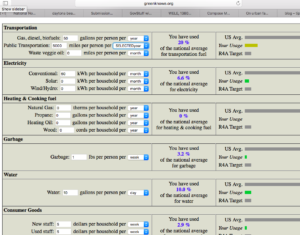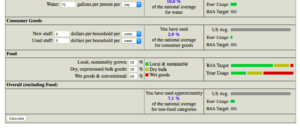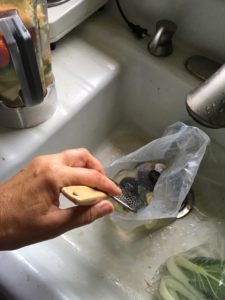(Part 2 of a 2-part post; read Part 1 here)
Internet use has a very large energy footprint. Most of that energy is consumed by remote servers and other equipment, making it complicated for everyday people to calculate their personal internet footprint. In this post I share some simple tips for reducing your online footprint, without having to perform any calculations or track down any numbers.
***IMPORTANT NOTE: Online footprint is a work in progress for me, and I’m finding out I may be one of the worst offenders! I’m learning that this blog and website may have a huge footprint, which of course is unintended. I am now looking into the scope of the problem, and how to address it.*** UPDATE 11/3/18: My tentative conclusion is that this website does not have a particularly large footprint. I’m still awaiting more information from my webhosting service. That said, I was immediately able to cut the bandwidth of my site in half just by reducing the size of the uploaded photos to match their display size. HUGE reductions in bandwidth and storage space can be achieved by reducing the size of photos.
According to some experts, internet use now accounts for as large a share of the world’s carbon footprint as airline flight! As I mentioned in Part 1 of this post, the internet infrastructure industry can reduce its footprint considerably by eliminating inefficiencies; for example, servers running when they don’t need to.
But the real power lies in our personal everyday choices. So how can we as everyday people do our part to reduce the internet’s footprint? How do we even calculate our share of it? The electricity used to power our household computers and devices is a tiny drop in the bucket. Most of the energy cost of the uploading, downloading, streaming, and cloud storage we do is external and invisible to us.
One Riot for Austerity member suggested that we use online time (hours per day) as a measure of our internet footprint. For a starting point, I googled and found:
• The average American spends 24 hours a week online, says Technology Review. This is up from 9.4 hours a week in 2000. 17.6 of those hours are at home, up from just 3.3 hours a week in 2000.
• Americans devote more than 10 hours a day to screen time, according to CNN. But this includes non-internet devices such as TVs too.
I spend an average of 5 to 8 hours a day on the internet. Probably 95% of that time is related to my work. Since I don’t have a TV or DVD player, all of my screen time is laptop or smartphone.
In the past few days, since starting to focus on the topic of online footprint, I’ve cut my actual internet-connected time to about 3-4 hours a day just by being more deliberate: I disconnect the wireless connection unless I’m actually doing something such as uploading a blog post, or interacting on Facebook. I’m experimenting with composing blog posts offline. I really notice how much online time I was using just gazing and surfing idly, or hitting the refresh button.
Another possible measure of internet footprint is how much cloud storage we are using. KOOFR, a cloud-storage company, posted an article on how much cloud storage an average person might want. KOOFR says 10GB will be enough for about a year — assuming you only want to back up the photos you’re taking with your phone, and that you upload an average of just 3 photos per day and one 1-minute video per week. Obviously some of us do a lot more than that! The KOOFR article also has a handy chart showing the storage requirements of various kinds of files including movies, music files, documents, and ebooks.
I don’t have any of my devices backed up to the cloud (I use memory sticks to back up crucial files), but of course my blog and YouTube channel live on the cloud, as does my Facebook and other social-media presence, and some email messages. I’m currently in the process of calculating the cloud storage used by this blog, and by my YouTube channel.
And yet another measure of our internet footprint is the bandwidth we are using. If you have a data plan on your smartphone, and that data plan has a limit, it should be pretty easy to know roughly how much bandwidth is being consumed by your uploading, downloading, and streaming activities. I haven’t yet determined whether there’s a similar way to find the total for a laptop or other computer.
As for how much electricity our online habits are using, this paper from ACEEE reports that “the Internet uses an average of about 5 kWh to support the utilization of every GB of data.”
It’s hard to know exactly how many gigs we’re consuming, since most of the consumption is externalized. The paper goes on to say, “Only 38% of those costs are borne by the end-user, while the remaining costs are thinly spread over the global Internet through which the data travels; in switches, routers, signal repeaters, servers, and data centers … This creates a societal ‘tragedy of the commons,’ where end users have little incentive to consider the other 62% of costs and associated resources.”
Powerful stuff, literally! Huge potential for footprint reduction.
Based on my research so far, here are a few suggestions for reducing your internet footprint:
– Set out to cut the number of hours you spend online per day. Think about what you would most like MORE of in your life: more time, feeling more focused and less distracted, being more present with others, spending less time sitting down and more time moving around — and with those goals in mind, you’ll find it easier to reduce online time.
– Close browser tabs when you’re not actively using a site (this affected my computer RAM usage, and affects streaming bandwidth as well).
– Be very deliberate and selective about your consumption of videos and other high-bandwidth media. Even in the case of content that you consider really worthwhile, try just reading the transcript (if available) rather than watching the video. Some people actually find this faster and retain the information better.
– Invite others to watch media with you – spread the footprint over more people! This also helps alleviate another major problem associated with our long hours in front of electronic screens, namely, loneliness and isolation.
– Some apps and sites, such as YouTube, allow users to set video viewing quality. Choose the lowest possible resolution.
– Have an “Internet Sabbath” day. I’ve been doing this on Sundays for awhile and the world hasn’t come crashing down.
– Turn off router and modem at night, or whenever you usually sleep. I’ve found this helpful because I used to be one of those people who would reach for her smartphone as soon as she woke up in the morning, or couldn’t sleep at night, etc. Nowadays, I go outside and look at the moon til I get sleepy again. Or count sheep or whatever. Or sometimes enjoy a realtime chat with one of my night-owl friends who I wouldn’t usually get to talk with!
– Decide to refrain from taking your smartphone or other device with you to certain places, such as church, restaurants, social evenings at friends’ houses, etc. Or if you have to take it with you, keep it turned off.
– Cut the data plan from your smartphone. I sharply reduced my internet use a few years back when I did this to save money. I used to check email and social-media sites constantly; now I can only do it when I have a wifi connection. It felt strange at first but I soon got used to it and enjoyed suddenly having hours of free time (as well as saving about $40 a month).
– Whatever reductions you pursue, take care that they don’t end up increasing your overall footprint and defeating the purpose. For example, if you start to take a lot more long-distance trips to visit friends and family as a result of quitting Facebook, or if you end up missing out on work opportunities because you dropped off the radar of your online communities, that’d be something to look at.
A final suggestion: If you’re using the internet for work, social activism, civic engagement, connecting with loved ones, and other beneficial purposes, don’t throw the baby out with the bathwater. Do what you reasonably can to reduce your footprint, but also recognize that the internet is a tool of modern life, and it’s done a lot of good to spread social movements and help people stay connected. And it’s expanded the possibilities for teleworking! Rather than quit Facebook, stop blogging, and so on, we’d do better to boost the QUALITY of our online time in terms of emotional wellbeing, beneficial impact on other people, and so on.
A couple of examples from my own life:
• Not having an internet connection at home could be an option for me someday, but I’d have to write a lot offline and then go to a public wireless network to upload a batch of material all at once. That would take discipline and might improve the quality of my work — or it might just make life inconvenient and I’d end up posting less, thus limiting my ability to support people in their efforts to reduce their footprint.
• I may delete my YouTube channel. For the moment, pending further research, I’m simply suspending new uploads to my channel. The videos take a lot of energy (my personal energy, not just fossil), and the quality is less than professional. I suspect that my writing and my in-person education services are reaching people more effectively. But I could find out that I’m mistaken.
The Riot for Austerity sets targets for reducing one’s consumption by 90% of the U.S. average in various categories such as electricity, water, gasoline, and consumer purchases. No Riot category exists for internet usage. Calculating the U.S. average and setting targets for online footprint will be new terrain.
I’ll let you know what else I find out about my internet footprint, and how my reduction experiments go. Research I still need to do: Calculate the footprint of this blog, and also of my YouTube channel. My blog webhosting service, Dreamhost, has first-rate tech support, and I’ll let you know what I hear back from them after I email them with my various questions.
Also, I invite you to keep me posted on your journey! I apologize for the inconvenience of not allowing comments on this blog, but comment-spam takes so much time and energy to deal with (even with a spam filter), I’ve decided to keep comments turned off at least for now. I look forward to your emails though.
Further Reading:
• Internet Energy Consumption Report from ACEEE: “This paper is a thought-piece on the how’s and why’s of end-to-end, IT energy use. It will pursue questions like: What type of equipment is used to get a MB from the data-center to your desktop? Is multi-tabbed browsing the IT equivalent of leaving the refrigerator door open? How much energy does it use? How much does it cost; and who pays for it?”
• Greenpeace article on how much energy the various video-streaming services use, and the percentages of renewable energy that power them.
• Article on bandwidth of video-streaming services vs. audio: video-streaming takes up much more bandwidth than audio-only music-streaming. This article shares ways for users to control their bandwidth consumption (which, depending on your data plan, can help save your wallet as well as the planet!)
• Why your internet habits are not as clean as you think (bbc.com): Lots of info here. No surprise that watching videos accounts for the biggest share of internet traffic, 60%, and that online video-watching alone accounts for 1% of total annual carbon emissions worldwide. Also: Emojis have a greater footprint than plain text (never thought about it, but it makes sense). And, an email with one photo attachment can have nearly 170 times the carbon emissions of one without. And this: “By simply stopping unnecessary niceties such as “thank you” emails we could collectively save a lot of carbon emissions. If every adult in the UK sent one less “thank you” email, it could save 16,433 tonnes of carbon a year – the equivalent to taking 3,334 diesel cars off the road…”



